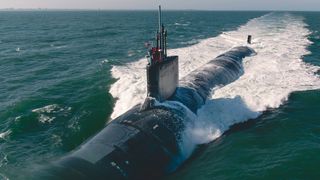The debate in Australia about the optimal pathway to acquire nuclear-powered attack submarines (SSN) under AUKUS is essentially split between two lines of argument. One maintains the government has not made a sufficient case for moving to an SSN capability; the other ignores the operational question and instead is fixated on questions of sovereignty, alliance management, politics, American hegemony and arms races.
With next week’s announcement outlining the pathway for building SSNs, it is time to go back to the debate that should have happened from the beginning – what is the strategic purpose of nuclear-powered submarines in an era of intensifying geopolitical rivalry?
Unpacking the benefits and rationale of the SSN capability and linking it to Australia’s military approach to the region, its relations with its US ally and key partners is essential in cutting through the competing views and developing our understanding of why two leaders as different as Scott Morrison and Anthony Albanese both chose to embark Australia on this whole-of-nation endeavour.
The overarching rationale for a submarine capability rests on Australia’s geography and strategic circumstances. While a continent, Australia is also an island and 99 per cent of the country’s trade comes (and goes) via cargo ship. Thus Australia’s maritime approaches and their security are essential to national survival, peace and prosperity. The sea lines of communication are the lifeblood of Australia, the navy its primary guardian and submarines the navy’s most effective tool.
The utility of submarines is not lost on other nations in the region. China has 58 submarines, and this is expected to grow to 76 by the 2030s.
Submarines provide stealth, sea denial and force projection. Most important, they are the best anti-submarine warfare capability. As Defence Minister Richard Marles has noted, “By virtue of their stealth and unique capabilities, submarines can place the single biggest question mark in our adversaries mind.” This is key to deterrence.
The utility of submarines is not lost on other nations in the region. China has 58 submarines, and this is expected to grow to 76 by the 2030s. During the past 15 years, China has constructed 12 nuclear boats. Japan is increasing its fleet from 16 to 22 conventionally powered submarines. South Korea, India, Pakistan, Thailand, The Philippines, Indonesia, Vietnam, Taiwan and Singapore have all been expanding, modernising or acquiring submarines.
The Collins-class of conventionally powered submarines has been the centrepiece of maritime operations for Australia for decades. But as technology and surveillance capabilities increase and the region becomes more contested, conventionally powered submarines, especially for a country with such vast maritime spaces and distances as Australia, are becoming more vulnerable. Conventional submarines are restricted in range by their diesel fuel tanks. Their ability to maintain stealth is dependent on limited battery life. And to keep those batteries charged they must come close to the surface to recharge them by running their diesel engines through a snorkel.
A key foundation of Australian strategy since the 1970s has been ensuring the Australian Defence Force can maintain a regional military capability edge. This way a large island nation with a small population and defence force can provide credible deterrence and response options. Quality – of technology, platforms, capabilities, operations and people – over quantity has been the key. One of the tenants of this approach has been to provide the ADF with a regionally superior submarine capability – but with a conventionally powered boat that edge is rapid eroding.
The transition to an SSN capability provides for an exponential increase in speed, manoeuvrability, survivability, and endurance. They are also vastly more lethal, being able to deliver long-range missiles. An SSN’s ability to maintain high speeds over extended periods means they manoeuvre quickly and provide a broader range of mission profiles, all while remaining submerged and undetected for months on end. They can essentially allow Australia to control critical maritime approaches before an adversary can.
Nuclear-powered submarines’ enhanced endurance means their time on station at key choke points to our north triples. In addition, as retired rear admiral Peter Briggs notes, their reactor provides “electrical power generation capacity (that) offers significant advantages in powering sensors and command, control, intelligence and combat systems and allows it to operate as a mothership or hub for remotely operated unmanned devices”.
For Britain, the rising importance of the Indo-Pacific is a key factor, but so is the advantage of pooling resources that allow economies of scale and faster innovation in undersea warfare for all three maritime democracies.
Thus, the move to nuclear-powered submarines provides for a leap in technology for the Australian submarine force – an essential factor in providing the ADF with a regional military capability edge in an era of great power competition.
This is possible because the US and Britain see Australia’s acquisition of this sovereign capability as essential to their own security. The Albanese government is determined to build the sovereign capabilities needed to defend Australia and, as US Studies Centre surveys show, 60 per cent of the American public agree that Australia’s capabilities make the US safer too.
The US is not transferring nuclear propulsion technology and potentially pulling Virginia-class boats off the production line just to make a buck, particularly when the US Navy is keen to get those same boats in service themselves. But greater Australian deterrence capability reinforces regional stability. For Britain, the rising importance of the Indo-Pacific is a key factor, but so is the advantage of pooling resources that allow economies of scale and faster innovation in undersea warfare for all three maritime democracies. A Centre for Strategic and International Studies report to congress eight years ago concluded that in the changing military balance of power in the Pacific, the US still retained a 15-year lead in submarine capabilities over adversaries and now that lead is being shared with two of America’s closest allies.
With brutal Russian aggression in Ukraine and China’s growing strategic interest in the Indian Ocean and the Pacific, Australia did not really have an option to ignore the most important capability available to secure the maritime domain. Nations such as Japan, India and Singapore that also depend on maritime security have understood what Australia is doing. Some states have been subjected to disinformation campaigns about AUKUS but will be the ultimate beneficiaries of a deterrence capability that makes the initiation of conflict much less attractive to any adversary in the region.
AUKUS is the most significant joint build of a maritime platform since the US transferred nuclear propulsion technology to Britain in 1958. There will be complex hurdles to overcome, from reforming the labyrinth of export control rules in the US to assembling the workforce needed in Australia. Australia will have to put deterrence platforms in the water while the new SSNs are being designed and built, and autonomous undersea vehicles and reportedly US submarines will help to fill that gap. But political leaders as savvy as Joe Biden, Albanese and Rishi Sunak do not travel halfway around the world to declare a pathway for something that they think cannot be built – or that does not enjoy strong bipartisan support in all three countries.
Perhaps that demonstration of unity and resolve is as powerful deterrence signal to the region as the technologies the three leaders announced.





